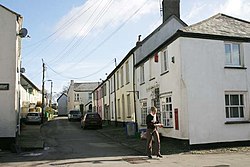High Bickington
| High Bickington | |
| Devon | |
|---|---|
 High Bickington High Street and Post Office | |
| Location | |
| Grid reference: | SS598209 |
| Location: | 50°58’13"N, 3°59’47"W |
| Data | |
| Population: | 1,668 (2011) |
| Post town: | Umberleigh |
| Postcode: | EX37 |
| Dialling code: | 01769 |
| Local Government | |
| Council: | North Devon |
| Parliamentary constituency: |
West Devon and Torridge |
High Bickington is a rural village in northern Devon, on the B3217 road, about a mile west of the River Taw valley, among largely cultivated hills and wooded valleys. The nearest larger settlements are Great Torrington (six miles to the west), South Molton (eight miles east), and Barnstaple (eight miles northward).
The village is on a slight ridge (whence the adjunctive 'High'), at around 520 feet, giving unbroken views across the valley towards Exmoor.
The full name also distinguishes High Bickington from two other Devon villages: Bickington (on Dartmoor, near Ashburton) and Abbot's Bickington in northern Devon, by the River Torridge.
History
The manor of High Bickington appears as Bichentone in the Domesday Book of 1086, which records that before the Norman Conquest, the manor belonged to Britric, nicknamed Meau ('the fair'), who also held rights to the land revenues of Gloucester and extensive estates in the West Country. He spurned the advances of Matilda, the Duke of Flanders' daughter and later the wife of William the Conqueror. She later imprisoned Britric and eventually had him put to death. All his lands passed to her, including Bichentona, Clovelly, Bideford, Winkleigh and Tiverton. The lands were later inherited by Matilda's son, William Rufus, who became William II of England.
William gave Bichentona to Robert Fitzhamon whose daughter was later married to Robert, 1st Earl of Gloucester, illegitimate son of Henry I. In around 1150 the manor of High Bickington came into the possession of the Champernownes of Umberleigh.
The population of the parish/village was given as 17 families, around a hundred people, at the time of the Domesday Book; this rose to a peak of 851 people in 1851. By 1901 it had fallen to 539, and it continued to fall to around 410 in the 1950s. Since then the population has steadily risen as a result of recent development.
Industry and facilities
Agriculture has always been and still is the main industry in the parish. In the past, the village was almost self-sufficient, but in modern times with the advent of the motor car most business now takes place away from the village, in towns such as Barnstaple, Bideford, Torrington and South Molton. The village still has a post office, shop, doctor's surgery, school, golf course and two pubs. The village has mobile services for fruit and vegetables and fresh fish, and a council library service. Building trades services can be found in and around the village. The village has a football team, cricket team and various pub-sport teams.
High Bickington is still largely unspoilt and retains much of the character of an isolated, rural country village, including many thatched cottages, cobbled pavements and narrow streets.[1]
Northcote Manor, a manor house, stands three miles south-west of the village and is now a hotel.[2]
Sport
- Badminton
- Cricket: High Bickington Cricket Club
- Football: High Bickington FC[3]
Outside links
| ("Wikimedia Commons" has material about High Bickington) |